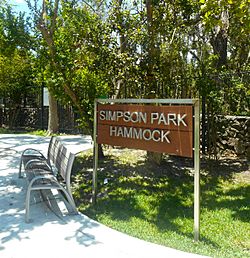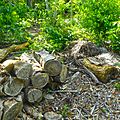Simpson Park Hammock facts for kids
Simpson Park, also known as Simpson Park Hammock, is a special nature park in Miami, Florida. It covers about 7.8 acres and is a green space in the middle of the city. This park helps protect a rare type of forest called a tropical hardwood hammock. It's one of the last places where you can see this kind of forest in the Brickell area.
The park sits on a slightly raised area called the Miami Rock Ridge. This spot is about 15 feet above sea level, which is quite high for Miami. In 1927, the park was renamed to honor Charles Torrey Simpson. He was a famous botanist (someone who studies plants) and a conservationist (someone who works to protect nature). A building called the Charles Torrey Simpson Garden Center was built in 1941. This building is also the main entrance to the park.
Simpson Park is very important for plants. It is home to 15 types of plants that are endangered, meaning they are at risk of disappearing forever. It also has 9 types of plants that are threatened. Because it's a natural area in a busy city, Simpson Park is like a "wild" spot where nature can thrive.
Contents
A Look at Simpson Park's History
Simpson Park was first created in 1913. Back then, it was known as Jungle Park. A group of people decided to set aside 5.5 acres of land. Their goal was to save a part of the Brickell Hammock. This was a large tropical forest that used to stretch from the Miami River all the way to Coconut Grove.
Over the years, the park grew bigger. In 1940, another 3 acres of the forest were added to the park. This helped protect even more of the unique plants and trees. The park became a key place for people to learn about and enjoy nature.
Plants and Wildlife in the Park
Simpson Park is like a living museum for plants. It has many unique trees and plants that are hard to find anywhere else. These plants are part of the tropical hardwood hammock ecosystem. This type of forest is very special because it grows in areas with limestone rock.
Some of the plants in the park are very rare. For example, you can find the Licaria triandra tree here. Protecting these plants helps keep our planet healthy. The park acts as a safe home for them.
Hurricane Irma's Impact
In September 2017, a very strong storm called Hurricane Irma hit Florida. The hurricane caused a lot of damage to Simpson Park. Many trees lost their leaves, and some were even broken. The park had to close for several months after the storm. This allowed time for the park to recover and for crews to clean up. It showed how powerful nature can be, but also how resilient it is.
Images for kids











